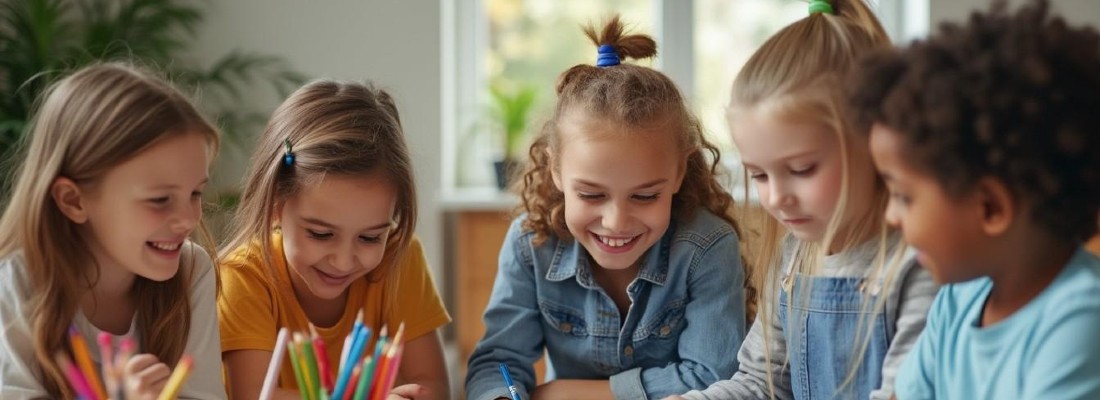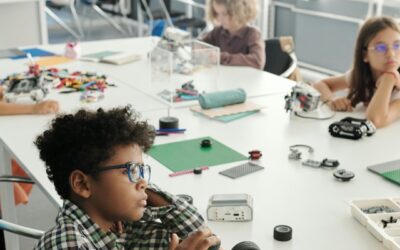As a parent, I know the struggle of keeping kids entertained indoors. My son Lincoln is always bursting with energy, even on rainy or scorching days when we’re stuck inside. One day, while watching him bounce off the walls, I had an idea.
Why not channel that enthusiasm into fun, educational activities?
Now, rainy days are opportunities for learning adventures. From building forts to learning coding basics, our indoor time has become a treasure trove of growth and bonding.
Types of Educational Indoor Activities for Kids
Kids indoor activities offer a wealth of opportunities for learning and development. These activities span various disciplines, engaging children in hands-on learning experiences that are both fun and educational.
Arts and Crafts Projects
Arts and crafts projects stimulate creativity and fine motor skills. Create a craft museum by encouraging kids to use paints, crayons, markers, and pipe cleaners to make art pieces.
Display their work and invite family members to view it. Make handprint art using paint or markers to create butterflies, leaves, or other designs. These projects are particularly beneficial for younger kids as they can enhance learning and promote fine motor skills.
Explore salt painting and suncatchers using templates like snowflakes or fireworks. Engage in recycled crafts, utilizing items around the house to make recycled crayons, cereal box aquariums, and paper bag puppets.
NATIONAL GEOGRAPHIC Mega Arts and Crafts Kit for Kids: Comprehensive kit for kids with mosaic, marbling paint, and air dry clay projects.
Arts & Crafts: Projects for Preschoolers: Book containing various arts and crafts projects suitable for preschoolers to enhance creativity.
Science Experiments
Fun indoor games like science experiments foster curiosity and critical thinking. Make homemade playdough and slime to teach kids about textures and materials.
Create fluffy, butter, rainbow, or clear slime varieties. Set up a mini lab with everyday household items to conduct simple experiments like creating a volcano eruption or growing crystals.
These hands-on activities introduce basic scientific concepts and encourage observation skills.
UNGLINGA 70 Lab Experiments Science Kits for Kids: Create different science experiments for kids with a variety of materials right in the box!
Magnet-Powered Car: Build a car that moves using magnets, teaching principles of magnetism and motion.
Literacy and Language Activities
Enhance literacy skills through engaging indoor recess ideas. Create a storytelling corner where kids can write and illustrate their own books.
- Play word games like Scrabble Junior or Boggle to expand vocabulary.
- Set up a puppet theater for dramatic storytelling, allowing children to act out their favorite tales or create new ones.
- Encourage journal writing to improve writing skills and self-expression.
Learn a New Language
Learning a new language can be an exciting and educational indoor activity for kids. With the abundance of online resources and language learning apps available, children can embark on a linguistic adventure right from home.
Parents can make this experience fun and interactive by incorporating various engaging methods. For instance, education science TV shows or movies in the target language can immerse kids in the sounds and rhythms of a new language.
- Listening to music and singing along to songs in the target language can also be a delightful way to practice pronunciation and vocabulary.
- Playing language learning games together can turn study time into a fun game, keeping kids engaged and motivated.
- Apps like Duolingo and Rosetta Stone offer gamified lessons that make learning feel like playing games.
Along with being a fun educational activity, learning a new language can significantly boost cognitive skills, improve memory, and enhance cultural awareness.
By exploring different languages, kids can develop a deeper understanding and appreciation of diverse cultures, broadening their worldview in a fun and educational way.
Math and Problem-Solving Games
Develop mathematical thinking with fun, interactive games. Use building blocks or LEGO to teach basic geometry and spatial reasoning. Play board games that involve counting, like Chutes and Ladders, or strategy games, like chess, to enhance problem-solving skills.
Create a home store to practice money skills and basic arithmetic. Introduce coding concepts with tech toys designed for kids, combining math and technology in an engaging way.
Physical and Sensory Activities for Indoor Learning
Physical and sensory activities are essential for children’s development, even when indoors. These activities promote physical movement, mindfulness, and sensory exploration, enhancing overall learning experiences.
Movement-Based Educational Games
Movement-based educational games combine physical activity with learning, making them perfect indoor activities for kids. Try “Simon Says” with educational twists, like “Simon says count by twos while jumping” or “Simon says spell your name while hopping.”
Another engaging option is “Musical Math,” where children dance to music and solve math problems when it stops. These games improve physical coordination while reinforcing academic concepts.
Kibbit Movers: Engaging board game improving vocabulary and categorization skills by sorting household items into rooms in an interactive way.
SimplyFun Kilter: Physics game for kids and adults, teaching balance and motion through strategic placement of blocks on a seesaw
Indoor Obstacle Courses
Transform your living space into an exciting indoor obstacle course.
Use household items like pillows, chairs, and tape to create a challenging path. Include educational elements by adding tasks like sorting objects by color or shape at different stations.
This hands-on learning activity for kids enhances problem-solving skills, spatial awareness, and physical coordination while keeping them engaged and active indoors.
Sensory Bins and Exploration
Sensory bins offer a tactile learning experience that stimulates multiple senses. Create themed bins using materials like rice, beans, or sand, and hide educational objects related to specific subjects. For example, a “space” themed bin might contain small planets, stars, and astronaut figures, encouraging exploration of the solar system. This activity promotes fine motor skills, sensory processing, and subject-specific learning in a fun, hands-on manner.
Creativity for Kids Sensory Bin: Construction Zone Playset: A construction-themed sensory bin filled with 2.5 lbs of sensory sand, excavator toys, and more for hands-on play.
Inspire My Play Sensory Bin with Lid and Removable Storage Inserts: A versatile, self-contained sensory bin with removable inserts for organizing play equipment and supplies, suitable for various age group.
Indoor Recess Games At Home
Indoor recess games at home are a fantastic way to keep kids active and engaged, especially during rainy or snowy days. These fun indoor activities can be easily adapted to fit different age groups and abilities, making them perfect for both classrooms and homes. Classic games like Simon Says, Red Light Green Light, and Freeze Dance are always a hit.
These games not only provide physical exercise but also help develop gross motor skills and improve coordination.
For a more educational twist, try incorporating academic challenges into these games. For example, in Simon Says, you can add tasks like “Simon says spell your name while hopping” or “Simon says count by fives while clapping.” These adaptations make the games more challenging and educational, reinforcing academic concepts while keeping kids busy and entertained.
Indoor recess games for your home also offer an excellent opportunity to enhance social skills. Playing games that require taking turns, following rules, and working together helps kids develop important social interactions and teamwork abilities.
Whether it’s a quick game of Duck, Duck, Goose or a more structured activity like a scavenger hunt, indoor recess games are a great way to keep kids engaged and active indoors.
Creative Play and Skill Development
Creative play and skill development activities provide children with opportunities to explore their imagination, enhance problem-solving abilities, and develop essential life skills. These indoor activities for kids combine fun and learning, promoting hands-on learning experiences that foster creativity and cognitive growth.
Pretend Play and Storytelling
Encourage your child’s imagination with pretend play and storytelling activities. Set up a dress-up corner with various costumes and props, allowing kids to create their own characters and scenarios.
Playing charades for kids is a great way to help your child tell a story while also learning about the world around them. Plus, charades is a great way for the whole family to play together!
This activity enhances social skills, creativity, and role-playing abilities. Create paper bag puppets using craft materials, enabling children to bring their stories to life and improve their creative storytelling skills. Introduce fortune tellers (cootie catchers) as a fun way to combine storytelling with simple origami, promoting social interaction and creativity while reviewing academic concepts.
Building and Construction Activities for Fine Motor Skills
Engage your children in building and construction activities to develop their spatial awareness and problem-solving skills. Provide building toys like blocks, LEGO, or magnetic tiles for free play, fostering creativity, fine motor skills, and coordination. Set up an indoor obstacle course using household items to challenge your child’s physical abilities and critical thinking.
For a more elaborate project, organize a box-building adventure using cardboard boxes, tape, markers, and scissors. This activity encourages children to design and construct anything from spaceships to mini cityscapes, promoting imagination, storytelling, and spatial reasoning.
Music and Dance Learning
Incorporate music and dance into your child’s indoor activities to enhance their cognitive and physical development. Create homemade instruments using household items like rice shakers or rubber band guitars, encouraging exploration of rhythm and sound.
Organize dance parties with educational twists, such as freeze dance games that incorporate math or spelling challenges. Introduce basic music theory through fun activities like creating a musical scale with water glasses or learning simple songs on a keyboard or xylophone.
These activities not only provide entertainment but also improve coordination, memory, and auditory processing skills.
Dance Party
A dance party is a lively and engaging way to get kids moving and having fun indoors. Simply put on some upbeat music and let the kids dance their hearts out. This fun indoor activity not only helps burn off energy but also promotes physical fitness and coordination. Parents can make the dance party even more exciting by creating their own dance routines or following along with dance videos available online.
Incorporating educational elements into the dance party can make it even more beneficial. For instance, you can play freeze dance games where kids have to solve a math problem or spell a word when the music stops. This adds an educational twist to the fun game, reinforcing academic skills while keeping kids entertained.
A dance party also encourages creativity as kids explore different dance moves and express themselves through movement. It’s a fantastic way to enhance gross motor skills, improve coordination, and boost creativity. Plus, it’s a fun and interactive way to keep kids engaged and active, making it a perfect indoor activity for any day.
Life Skills and Cultural Education
Educational indoor activities for kids can significantly contribute to developing essential life skills and cultural awareness. By engaging in hands-on learning experiences, children can explore diverse cultures, develop practical abilities, and broaden their understanding of the world around them.
Cooking and Baking Activities
Introduce your kids to the culinary world through cooking and baking activities. These hands-on experiences teach valuable life skills while providing a delicious reward:
- Create a mini cooking show where kids prepare simple recipes
- Explore international cuisines by making dishes from different countries
- Teach measuring skills through baking projects like cookies or muffins
- Encourage kids to design their own recipe cards for family favorites
Gardening Indoors
Transform your home into a green oasis with indoor gardening activities that teach kids about plant life and environmental responsibility:
- Start a windowsill herb garden using recycled containers
- Create a terrarium to showcase different plant ecosystems
- Grow microgreens for a quick and educational harvest
- Conduct plant growth experiments using different variables like light and water
Learning About Different Cultures
Expand your children’s cultural horizons through engaging activities that celebrate diversity:
- Host a multicultural day featuring foods, music, and traditions from various countries
- Create a world map collage using pictures from magazines or online resources
- Learn basic phrases in different languages through interactive games or apps
- Organize a virtual tour of famous landmarks and museums around the world
Incorporating these indoor educational activities’ll provide your kids with enriching experiences that foster life skills, cultural understanding, and a broader worldview.
Technology-Based Educational Activities
Technology offers numerous opportunities for engaging and educational indoor activities for kids. By leveraging digital tools, you can provide your children with interactive learning experiences that are both fun and enriching.
Educational Apps and Online Games
Educational apps and online games transform learning into an enjoyable experience for kids. These digital platforms cover a wide range of subjects, making them versatile tools for hands-on learning:
- Math toys for kids: Apps like Khan Academy Kids offer interactive math lessons that adapt to your child’s learning pace.
- Language learning: Duolingo provides engaging language lessons through gamified exercises.
- Science and nature: National Geographic Kids offers games and activities that explore various scientific concepts.
- General education: ABCmouse and PBS Kids provide comprehensive educational content across multiple subjects.
Virtual Museum Tours
Virtual museum tours bring the world’s cultural treasures directly to your home, offering educational kids activities without leaving your living room:
- The Smithsonian Museums offer interactive exhibits and educational content that cover history, science, and art.
- The Louvre provides virtual tours of its world-renowned art collections, allowing kids to explore masterpieces up close.
- Many museums feature special kid-friendly virtual tours with engaging narratives and interactive elements.
Coding for Kids
Introducing coding to kids is an excellent way to develop problem-solving skills and logical thinking:
- Scratch: A free, block-based coding platform designed for children aged 8-16.
- Code.org: Offers a variety of coding courses suitable for different age groups and skill levels.
- Tynker: Provides coding lessons through interactive games and projects.
These tech toys for kids not only entertain but also prepare them for a future where digital literacy is crucial.
Group Activities for Social Learning
Group activities for social learning are essential indoor activities for kids that promote collaboration, communication, and teamwork. These activities not only keep children engaged but also help develop crucial social skills in a fun and interactive environment.
Board Games with Educational Value
Board games offer an excellent opportunity for kids to learn while having fun. Choose educational board games that focus on specific subjects like math, language, or science to enhance learning. Games like Scrabble improve vocabulary, while Monopoly teaches basic financial concepts. For younger children, try games like Counting Candies or Sum Swamp to reinforce math skills in an enjoyable way.
Collaborative Art Projects
Engage kids in collaborative art projects to foster creativity and teamwork. Set up a large mural project where each child contributes to a section, or create a group sculpture using recycled materials. These hands-on learning activities for kids encourage sharing ideas, problem-solving, and working towards a common goal. Consider theme-based projects that align with current school topics to reinforce learning while promoting social interaction.
Team-Building Exercises
Incorporate team-building exercises into your indoor activities for kids to develop leadership skills and cooperation. Organize a mini-Olympics with various challenges that require teamwork, such as a three-legged race or a puzzle-solving relay. Create an indoor scavenger hunt where kids work in teams to solve clues and find hidden objects. These exercises not only provide entertainment but also teach valuable skills like communication, strategic thinking, and mutual support.
Quiet Time Activities for Individual Learning
Quiet time activities offer kids opportunities for focused, individual learning. These educational indoor activities for kids promote concentration, creativity, and cognitive development while providing a peaceful environment for exploration and growth.
Reading and Book-Related Activities
Reading is a cornerstone of educational kids activities. Encourage your child to read aloud, enhancing their literacy skills and confidence. Create themed book lists based on their interests to keep them engaged. Incorporate hands-on learning for kids with book-related crafts, such as making creative bookmarks inspired by their favorite characters. Try activities like “Sift-N-Spell” or “Spine Poetry” to make literacy fun and interactive.
Puzzles and Brain Teasers
Puzzles and brain teasers are excellent indoor games for kids that promote critical thinking and problem-solving skills. Introduce classic board games like checkers or chess to develop strategic thinking. Jigsaw puzzles enhance spatial awareness and patience. For younger children, shape-sorting toys and simple logic games can be engaging and educational. These activities serve as effective STEM kits for kids, fostering analytical skills and cognitive development.
Mindfulness and Relaxation Techniques
Incorporating mindfulness and relaxation techniques into your child’s quiet time can improve focus and emotional regulation. Teach simple breathing exercises or guided imagery to help them calm their minds. Create a quiet corner with soft cushions and calming pictures where they can practice these techniques. Introduce kid-friendly yoga poses or gentle stretching exercises to combine physical activity with relaxation. These mindfulness activities contribute to overall well-being and can enhance learning capacity.
Conclusion
Educational indoor activities offer a world of opportunities for your children’s growth and development. By incorporating these engaging and diverse activities into your home routine you’re nurturing creativity problem-solving skills and a lifelong love for learning.
From hands-on experiments to virtual explorations these activities transform ordinary days into extraordinary adventures.
Remember the key is to make learning fun interactive and tailored to your child’s interests. With these activities at your fingertips you’re well-equipped to turn any indoor day into a meaningful educational experience that your kids will cherish.















0 Comments